
Now the 12i + 2i simplifies to 14i, of course. What about the 8i2? Remember we introduced i as an abbreviation for √–1, the square root of –1. In other words, i is something whose square is –1. Thus, 8i2 equals –8. Therefore, the product (3 + 2i)(1 + 4i) equals –5 + 14i.
If you generalize this example, you’ll get the general rule for multiplication

Remember that (xu – yv), the real part of the product, is the product of the real parts minus the product of the imaginary parts, but (xv + yu), the imaginary part of the product, is the sum of the two products of one real part and the other imaginary part.
Let’s look at some special cases of multiplication.
In other words, you just multiply both parts of the complex number by the real number. For example, 2 times 3 + i is just 6 + 2i. Geometrically, when you double a complex number, just double the distance from the origin, 0. Similarly, when you multiply a complex number z by 1/2, the result will be half way between 0 and z. You can think of multiplication by 2 as a transformation which stretches the complex plane C by a factor of 2 away from 0; and multiplication by 1/2 as a transformation which squeezes C toward 0.
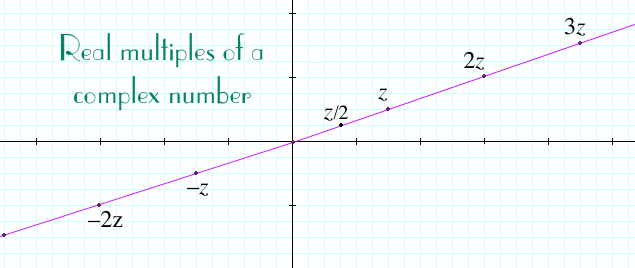

The verification of this identity is an exercise in algebra. In order to prove it, we’ll prove it’s true for the squares so we don’t have to deal with square roots. We’ll show |zw|2 = |z|2|w|2. Let z be x + yi, and let w be u + vi. Then, according to the formula for multiplication, zw equals (xu – yv) + (xv + yu)i. Recall from the section on absolute values that
Similarly, we have
and, since zw = (xu – yv) + (xv + yu)i,
So, in order to show |zw|2 = |z|2|w|2, all you have to do is show that
and that’s a straightforward exercize in algebra.
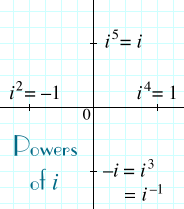 Next consider i4. That’s the square of i2, that is, the square of –1. So i4 = 1. In other words, i is a fourth root of 1. You can show that –i is another fourth root of 1. And since both –1 and 1 are square roots of 1, we now know all four fourth roots of 1, namely,
1, i, –1, and –i. This observation connects to the Fundamental Theorem of Algebra since the equation z4 = 1 is a fourth-degree equation so must have exactly four roots.
Next consider i4. That’s the square of i2, that is, the square of –1. So i4 = 1. In other words, i is a fourth root of 1. You can show that –i is another fourth root of 1. And since both –1 and 1 are square roots of 1, we now know all four fourth roots of 1, namely,
1, i, –1, and –i. This observation connects to the Fundamental Theorem of Algebra since the equation z4 = 1 is a fourth-degree equation so must have exactly four roots.
Higher powers of i are easy to find now that we know i4 = 1. For example, i5 is i times i4, and that’s just i. You can reduce the power of i by 4 and not change the result. For another example, i11 = i7 = i3 = –i.
How about negative powers of i? What is the reciprocal of i,
that is, i–1? For the same reason that you can subtract 4 from a power of i and not change the result, you can also add 4 to the power of i. That means i–1 = i3 = –i. Thus, the reciprocal of i is –i. Imagine–a number whose reciprocal is its own negation! Of course, it’s easy to check that i times –i is 1, so, of course,
i and –i are reciprocals.
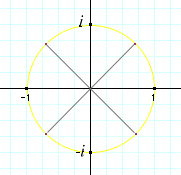
We can use geometry to find some other roots of unity, in particular the cube roots and sixth roots of unity. But let’s wait a little bit for them.
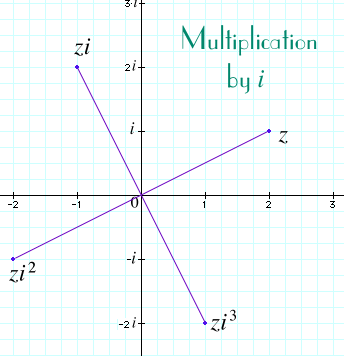 Let's interpret this statement geometrically. The point z in C is located x units to the right of the imaginary axis and y units above the real axis. The point z i is located y units to the left, and x units above. What has happened is that multiplying by i has rotated to point z 90° counterclockwise around the origin to the point z i. Stated more briefly, multiplication by i gives a 90° counterclockwise rotation about 0.
Let's interpret this statement geometrically. The point z in C is located x units to the right of the imaginary axis and y units above the real axis. The point z i is located y units to the left, and x units above. What has happened is that multiplying by i has rotated to point z 90° counterclockwise around the origin to the point z i. Stated more briefly, multiplication by i gives a 90° counterclockwise rotation about 0.
You can analyze what multiplication by –i does in the same way. You'll find that multiplication by –i gives a 90° clockwise rotation about 0. When we don't specify counterclockwise or clockwise when referring to rotations or angles, we'll follow the standard convention that counterclockwise is intended. Then we can say that multiplication by –i gives a –90° rotation about 0, or if you prefer, a 270° rotation about 0.
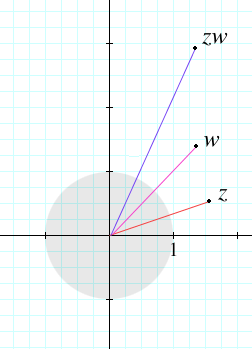
Let z and w be points in the complex plane C. Draw the lines from 0 to z, and 0 to w. The lengths of these lines are the absolute values |z| and |w|, respectively. We already know the length of the line from 0 to zw is going to be the absolute value |zw| which equals |z| |w|. (In the diagram, |z| is about 1.6, and |w| is about 2.1, so |zw| should be about 3.4. Note that the unit circle is shaded in.) What we don't know is the direction of the line from 0 to zw.
The answer is that “angles add”. We'll determine the direction of the line from 0 to z by a certain angle, called the argument of z, sometimes denoted arg(z). This is the angle whose vertex is 0, the first side is the positive real axis, and the second side is the line from 0 to z. The other point w has angle arg(w). Then the product zw will have an angle which is the sum of the angles arg(z) + arg(w). (In the diagram, arg(z) is about 20°, and arg(w) is about 45°, so arg(zw) should be about 65°.)
In summary, we have two equations which determine where zw is located in C:

